International Series of Numerical Mathematics
1 primary work • 2 total works
Book 63
Improperly Posed Problems and Their Numerical Treatment
by Prof. Dr. G. Hammerlin and Prof. Dr. K.-H. Hoffmann
Published 1 January 1983
Whilst improperly posed problems appear in several branches of applied and pure mathematics, this conference concentrated mainly on the practical treatment of ill- posedness. The participants came from 12 countries. The interchange of ideas reflected the spectrum of questions arising in connection with the subject of the conference, where currently progresses in research are made. This volume contains 17 papers presented at the con- ference. Focal points in the programme were: Problems of regularisation, parameter identification, free boundary and inverse problems in differential equations and inte- gral equations of the first kind. Problems, which appear in science, in technical fields and in medicine are dis- cussed as well as general operator equations. In a jOint discussion, several open problems have been worked out which are collected at the end of the volume. The editor's thanks go to all contributors and parti- cipants who made the conference a success; to the manage- ment of the institute with its unique atmosphere; to the Birkhauser Verlag for the possibility to publish the vo- lume in the well-known ISNM series; to Dr. P.
Jochum (Mlin- chen) for assistance in organization and to Mrs. Chr. Rogg (Augsburg) for her excellent typing of several manuscripts.
Jochum (Mlin- chen) for assistance in organization and to Mrs. Chr. Rogg (Augsburg) for her excellent typing of several manuscripts.
v. 112
Algorithms for the numerical computation of definite integrals have been proposed for more than 300 years, but practical considerations have led to problems of ever-increasing complexity, so that , even with current computing speeds, numerical integration may be a difficult task. High dimension and complicated structure of the region of integration and singularities of the integrand are the main sources of difficulties. This volume contains 27 papers presented at the fourth conference on numerical integration held at the Mathematical Research Institute, Oberwolfach, in November 1992. The contributions give a survey of the latest results in quadrature and cubature. Since the subject matter lies somewhere between practical mathematics and analysis, a wide spectrum of topics is discussed. One main theme is the construction of rules, especially for integrands with singularities. Further focal points are error estimation in various classes of functions, structure of general rules of interpolatory type, lattice rules, and the many facets of the Gaussian rule. Many open problems were discussed in Oberwolfach, showing a liveliness and actuality of the theory.
Nine of these problems could be given precise formulations; they are collected at the end of this volume.
Nine of these problems could be given precise formulations; they are collected at the end of this volume.

